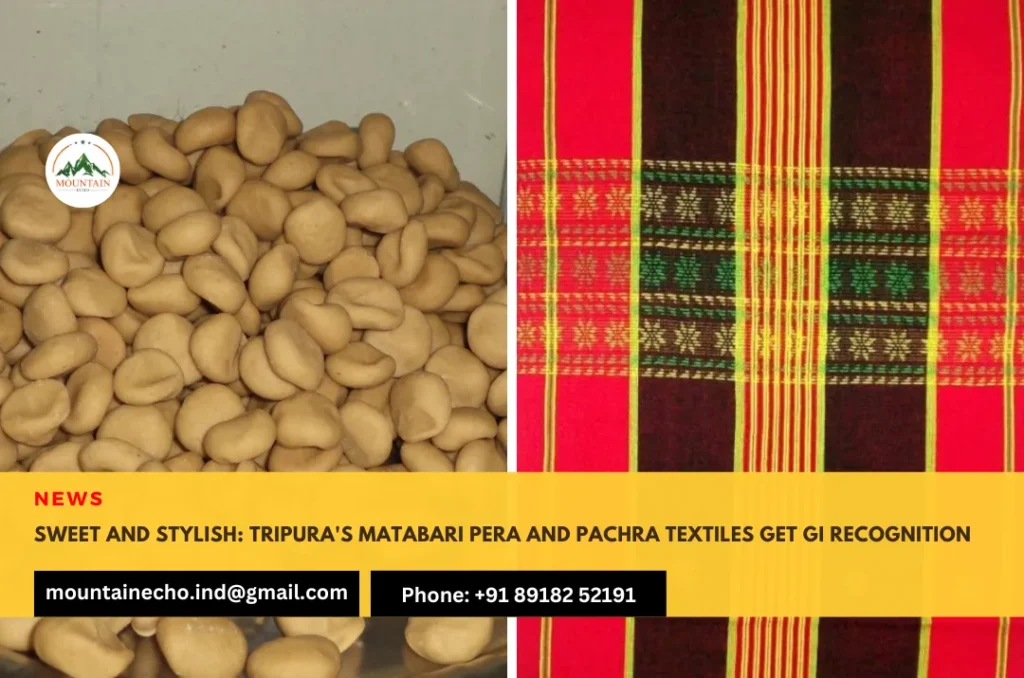Sweet and stylish: Tripura’s Matabari Pera and Pachra textiles get GI recognition
WhatsApp Channel
Join Now
Two of Tripura’s most distinctive products, the delectable Matabari Pera and the vibrant Pachra textiles, have been awarded the coveted Geographical Indication (GI) tag. This recognition, announced on March 31st, 2024, is a major boost for the state’s cultural heritage and traditional craftsmanship.
The GI tag signifies that these products have a unique character linked to their geographical origin. For Matabari Pera, this means the specific recipe and traditional preparation methods used near the temple contribute to its distinct taste. Pachra textiles, on the other hand, are recognized for the craftsmanship of local artisans and the use of indigenous materials in their weaving.
The Matabari Pera, a sweet dish made with milk and offered as prasad (offering) at the revered Tripurasundari Temple in Gomati district, is known for its unique flavor and texture. The GI tag ensures that only pera made in the traditional way and originating from this specific location can be labelled as “Matabari Pera.” This recognition is expected to not only elevate the sweet’s status but also protect its recipe and ensure its authenticity for future generations.
Pachra, also known as Rignai, is a handwoven cloth traditionally worn by the indigenous communities of Tripura. Crafted by skilled artisans using indigenous materials, Pachra textiles are known for their vibrant colors, intricate designs, and the cultural significance they hold. The GI tag for Pachra is a welcome recognition of the artistry and heritage associated with this beautiful textile. Experts believe this recognition will revitalize the weaving industry, which has seen a decline in recent years, by boosting demand and supporting traditional weavers.
Tripura Chief Minister Manik Saha hailed the GI tag as a significant achievement and credited the Prime Minister’s “Vocal for Local” initiative for its role in promoting local produce and handicrafts. He expressed his delight at the recognition bestowed upon these two emblematic products of Tripura and the potential it holds for the state’s economic development. He also commended Self Help Groups (SHGs) that played a key role in securing the GI tag for both Matabari Pera and Pachra.
মাতা ত্রিপুরাসুন্দরীর প্রসাদ তথা পেঁড়া আজ আন্তর্জাতিক স্বীকৃতি লাভ করেছে(GI Tag)। রাজ্যের জাতি-জনজাতি সহ সকল ধর্মপ্রাণ জনগনের কাছে এটি অত্যন্ত গর্বের বিষয়। pic.twitter.com/Rj7eUipe6N
— Prof.(Dr.) Manik Saha(Modi Ka Parivar) (@DrManikSaha2) March 31, 2024
The GI tag for Matabari Pera and Pachra textiles adds to Tripura’s growing list of GI-tagged products. The state’s famed Queen pineapple and Risa, a handwoven cloth worn by indigenous communities, have also received this recognition in recent times. This trend highlights Tripura’s rich cultural heritage and the potential of its traditional products to gain national and international recognition.
Self-help groups like the Matabari Mahila Cluster Level Bahumukhi Samabaya Samity and the Dewanbari Mahila Cluster Bahumukhi Samabaya Samity, who played a crucial role in securing the GI tag, are likely to see a rise in demand for their products. This recognition can potentially revitalize these traditional crafts, ensuring their survival for generations to come.
Telegram Channel
Join Now



